We can’t dance to these sets in a club at the moment, so let’s use this opportunity to really watch what’s happening. Techno madman Florian Meindl takes us inside the craft of playing his fully live, all-hardware set.
We’ve got detailed answers from Florian about how he works and plays, and copious links to all the gear he mentions. And this is techno, but the immediacy of it would be applicable in any genre.
There’s a ton of advice here – not only about what to use and how to use it, but also how to approach time. Check Florian’s answer to how he approaches balancing time working on sound design and researching and learning gear with practice applying that to tracks and live performance. And even for a hugely busy and prolific DJ/producer, that’s measured in months. So if you were wondering what to do with extended time in isolation, Florian’s a great model.
But let’s watch first. It really is a meeting of man, machine, and madness, in a precise but utterly brutal set.
Just hang onto your drinks and please don’t spill it on his gear:
CDM: Can you walk us through the rig that’s here? What are you working with? I see a lot of fun with Arturia’s MicroFreak. I know you talked about the Pioneer drum machine.
Florian: My current live setup is a combination of two almost independent small setups, I wanted to structure it like this because it gives me more security in a live situation where the show must go on even if there is a technical problem.
So there is the left side which consists of the [Pioneer] Toraiz SP-16 sampler which also gives out the main MIDI clock and the Arturia MicroFreak which is not only connected via MIDI but also the audio signal goes into the Toraiz.
I did that in order to have fewer audio channels going to the mixer and also because the SP-16 can add an effect to the incoming audio — and in the case of the MicroFreak, this is very useful, because it doesn’t have effects onboard.
So with the combination of those two machines, I could do a live act, but it would be a bit too minimal and limited for me so I also have the right side.
The right side of the setup consists of the TipTop Audio Mantis Modular case and many different modules plus the Arturia Beatstep Pro which sequences the modular synth.
In order to sync the left side with the right side I give a MIDI clock to the Beatstep Pro from the SP-16. If the left side stops working because somebody spills a drink on my gear,(happens statistically in 1 of 20 live shows of mine), then I can run the Beatstep Pro from its own clock!
The modular synth with the Beatstep Pro is able to play 16 different tracks, but they are limited in sound. I only have two oscillators in the modular synth and the drums are also not so much changeable, because I have mainly analog percussion generators and only one (12-bit) sampler. In reality, I perform a maximum of eight different tracks with it.
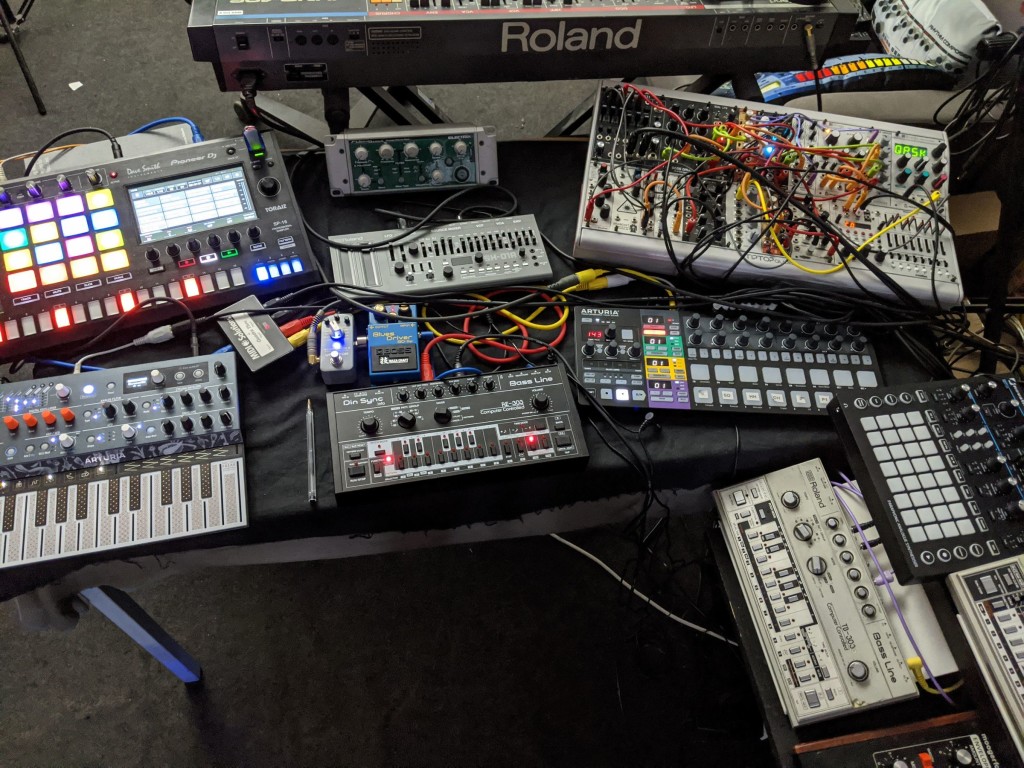
I like acid techno, so I have a 303 right in front of me – I tested a few including the original, and my favorite is the DinSync RE-303. It sounds exactly like the original, but with more features and a really cool black look. In order to have a larger variety of sound, I gave it a [BOSS] Bluesdriver distortion and a cheap small reverb.
In the Live stream video and on the setup pic there is also the original [Roland TB-]303, but I’m not using it for live — it was just in the picture. What I did use, though, was the Novation Circuit Mono Station. It’s a quite strong synth, because it combines analog sound generation and filter with digital sequencing, modulation and presets/ So I create a few good techno sequences in the studio, save them, and perform the live set later – this works really well because programming live can be difficult (although I try to improve those skills).
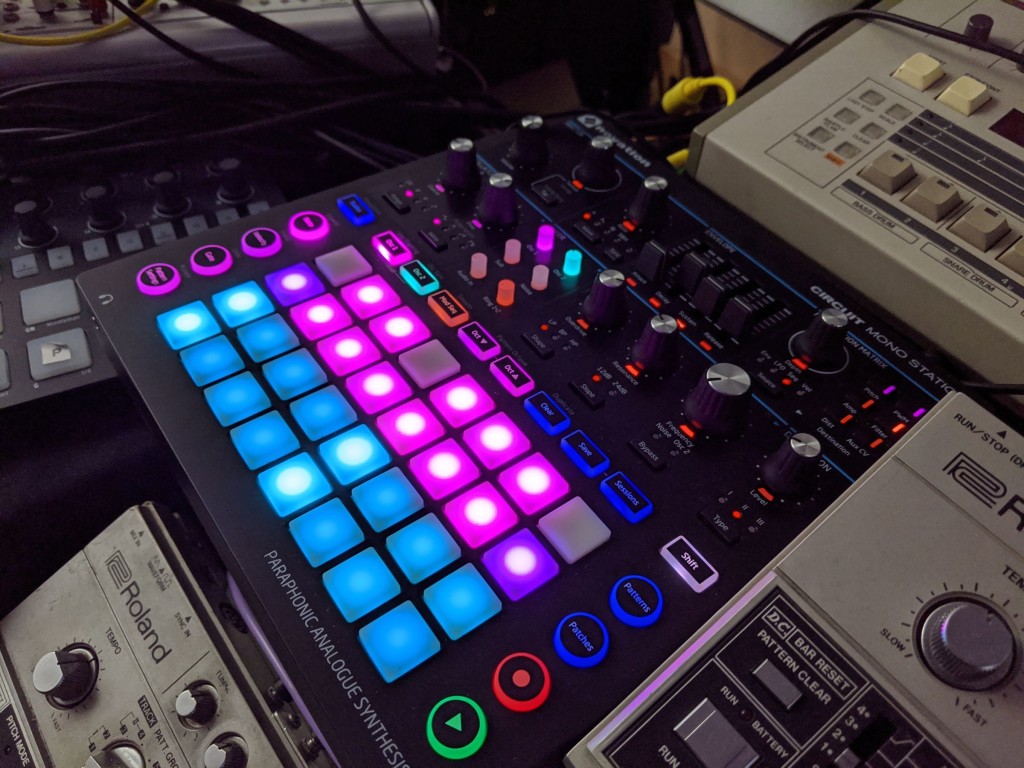
Ah, yes, and there is also the Roland Boutique SH-01A which is quite good for its small size, it needs a little spice though that’s why I routed it into an Electrix filter [Electrix Pro Filter Factory] which goes into a slightly clipping channel of my Mackie (1990s 8-Bus) mixer.
There is also an Eventide Space Reverb which is set up as a send/return effect in the Mackie mixer; I sometimes increased the send levels during the set on the mixer.
Apart from the mixer, what are the main elements you focus on performing with? Which are the bits you use primarily in improvisation?
Every track uses a slightly different combination of the machines you see in the picture.
- The drums either come from the Toraiz SP-16 or from the Modular Synth of from both.
- The vocals only come from the SP-16.
- The most performed piece of gear is maybe the RE-303 but also the analog drums from the modular.
I often change the level of distortion of the kick, its length. and also its tune. I tend to start the ride on a deeper pitch and then pitch it up during a break. The snare is kind of set up as a snare-roll because that gives a lot of energy in a live set – it works as a 16th hi-hat but also snare roll, depending on how long it is. That’s the nice thing about these Erica Synths and Tiptop Audio drums, I tune them live until they fit!
A feature that I often use is also the Dave Smith Instruments [now Sequential] highpass filter on the [Pioneer] SP-16. It’s so useful, because a high-pass kick still works best in the break of a track in the club.
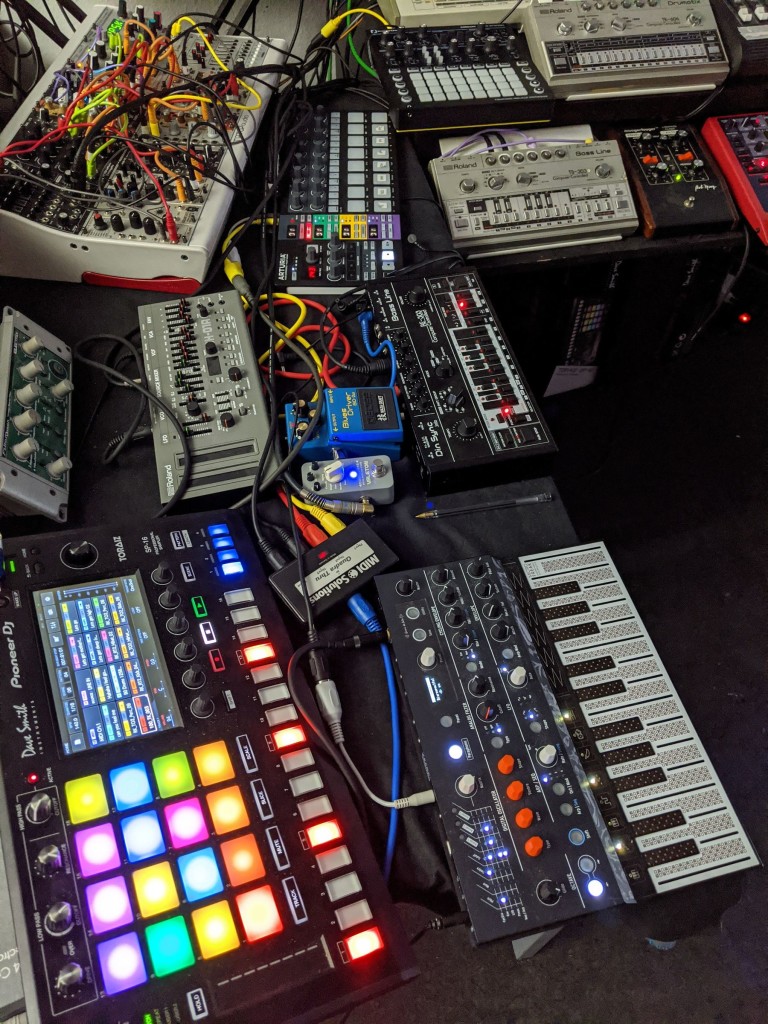
So we the public got to tune in for a nice juicy chunk of this. I mean, is this what we’d see if we were a fly on the wall in the studio? Or what’s your practice routine like. Is there a specific discipline to it / etudes or skills you work on?
The live set is kind of a current showcase of what I do in the studio, but condensed into just one hour and brought together into one performance. Usually I do only a fraction of the things at once, of course. When I record tracks I often use the layering technique, which means that I record the beat first and then layer a synth on top etc. – but sometimes I record tracks exactly like this, in one take!
I should practice playing the piano much more though I always find something more interesting to do like comparing three different distortion effects on a 303 for five hours….
What’s the modular up to here?
This is an own topic, but really quickly — it’s sequenced by the Beatstep Pro, which gives out gate and CV [control voltage] signals. The gates go to drum generators and envelopes of the oscillators. The CV goes to the [Mutable Instruments] Braids [oscillator]. There is also a sequencer named [Intellijel] Metropolis in the Modular which sends CV and gate to the Rings Oscillator.
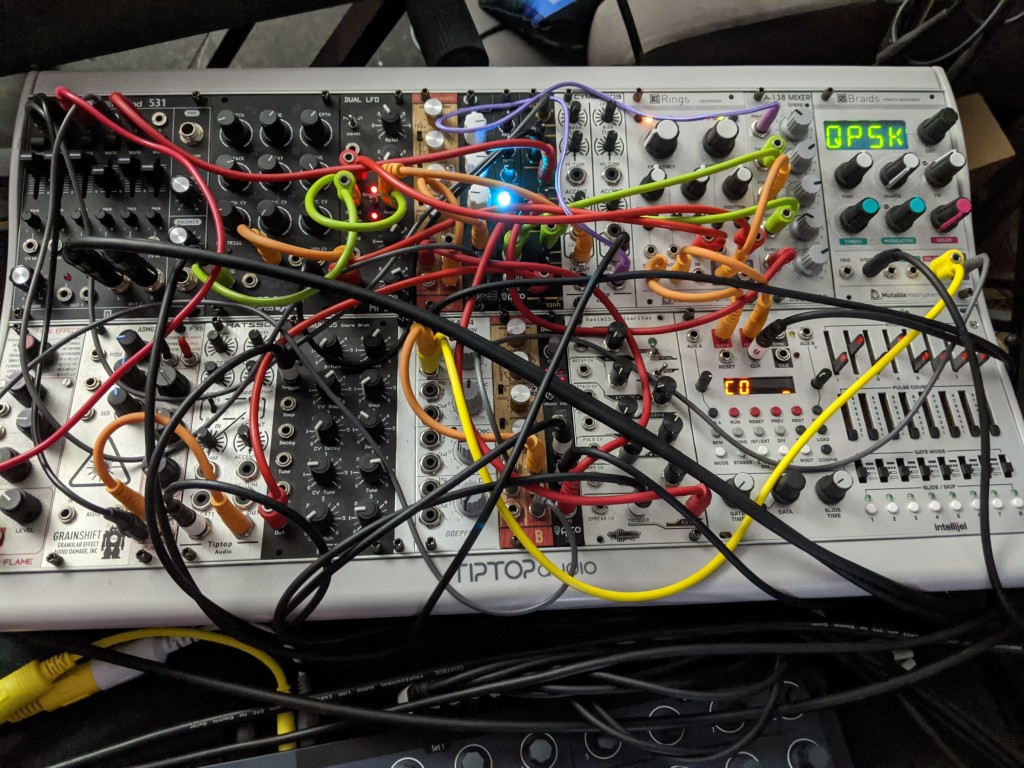
So there are two mono synth lines in the modular and the rest is drums. The kick drum is from Erica Synths [Bass Drum] and really versatile — it’s even got its own saturation on board/ The hi-hat and ride are from Tiptop Audio, the snare from MFB, and there’s another percussion module from Noiseengineering. [Ed. We’ve talked about the modules from Erica before, in the context of the Techno System.]
There is also a PICO DRUMS sampler from Erica Synths which has got some Riemann Kollektion Oneshots in the memory, the bit depth is reduced to 12bit which gives a strong crunchy sound!
Ed. You can try the PICO DRUMS free in VCV Rack (Mac/Windows/Linux) before you buy – https://library.vcvrack.com/EricaCopies/PicoDrums
And those one-shots are available from Riemann:
My favorite filter, the Bastl Instruments Cinnamon, functions also as a mixer; when I turn down the cutoff, the sound disappears. This way, I save mixer channels!
The internal mixer is from the Roland System 500 series and really good for performing live. It has faders, but also mute buttons, and for stereo effects the pan-pot can be modulated. [Ed.: Great minds; thought that would be useful for performance when we first wrote it up! See the 531 MIX module.]
How were you working with the Riemann Kollektion samples?
All samples inside the Toraiz SP-16 are from the Riemann Oneshots Bundle and the PICO DRUMS sampler in the modular synth has got the Riemann Distorted Drums inside. The rich and full sound of the samples make them live ready – they don’t even need much compression or saturation afterward.
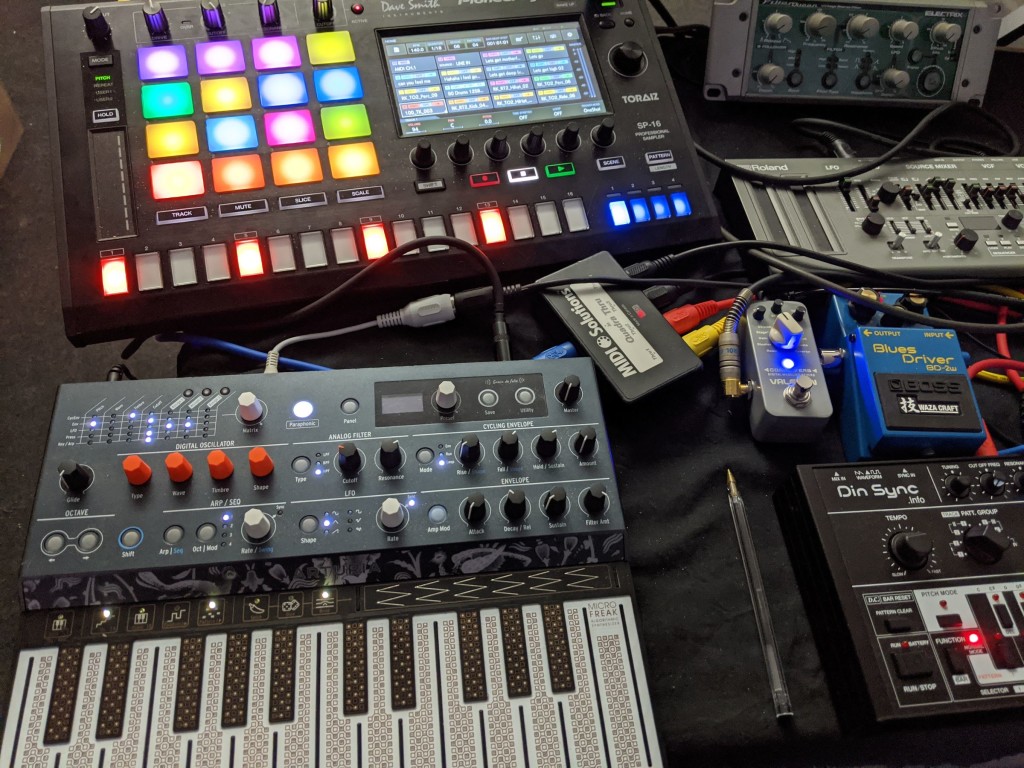
Actually, on that wavelength — do you have time for your own sets that you dedicate to sound design? Is there some advance preparation there that’s separate from music-making; are there times you devote to just creating your sound palette?
Yes, what you see in this live set is just the tip of the iceberg. It’s where huge amounts of different aspects of sound design, musical taste, and experience — the love for technical processes and music performance — come together.
I often don’t record full pieces of music for up to five months. During these cycles I do all the things which are not this visible tip of the iceberg – the things people don’t see in my Instagram posts. That includes things like experimenting with electronic instruments, looking for new synth modules or a better configuration of my modular rack, trying new synths and playing around without a clear target, learning new methods of sound design, mixing, and music-making, and also creating loops and sounds for Riemann Kollektion.
Also listening to music is a big part of music education. Once you know how to make music, you hear it from another perspective. So just by listening to music, I don’t know, a firework of thoughts and ideas can come up and ignite something in me which makes me wanna go to the studio immediately and try out things.
The kick is just massive. And it holds up even to Facebook streaming. Is that all there in the sounds to begin with, or are you also thinking about signal flow, compression, EQ as part of mixing this live?
Yes this is another hidden field which is very important to me, getting the best out of the sound in all aspects and in all situations. I also do mastering for my label FLASH Recordings and for a few selected clients like Richie Hawtin – and in mastering, I always try to get out this little extra, which is possible in almost all cases. It’s not about being the loudest technically – it’s actually almost only about psychoacoustics. This includes the right dose of overtones in the right moments, as well as the right balance of not only frequencies but also transients and volumes.
For this live stream, I used the 1990s Mackie 8-Bus mixer which I also use to record all my music. Some channels are clipping, some have a high boost and low boost, and all channels come together on a bus which includes an SSL compressor. [Ed.: Good article here from Gobbler on that bus compressor, which is available in various hardware and software copies.] It reduces the peaks with a fast attack by maximum 3db.
The Facebook stream had a bad audio quality compared to the master sound which comes out on my monitor speakers, but maybe Facebook and/or I can improve that in the future.
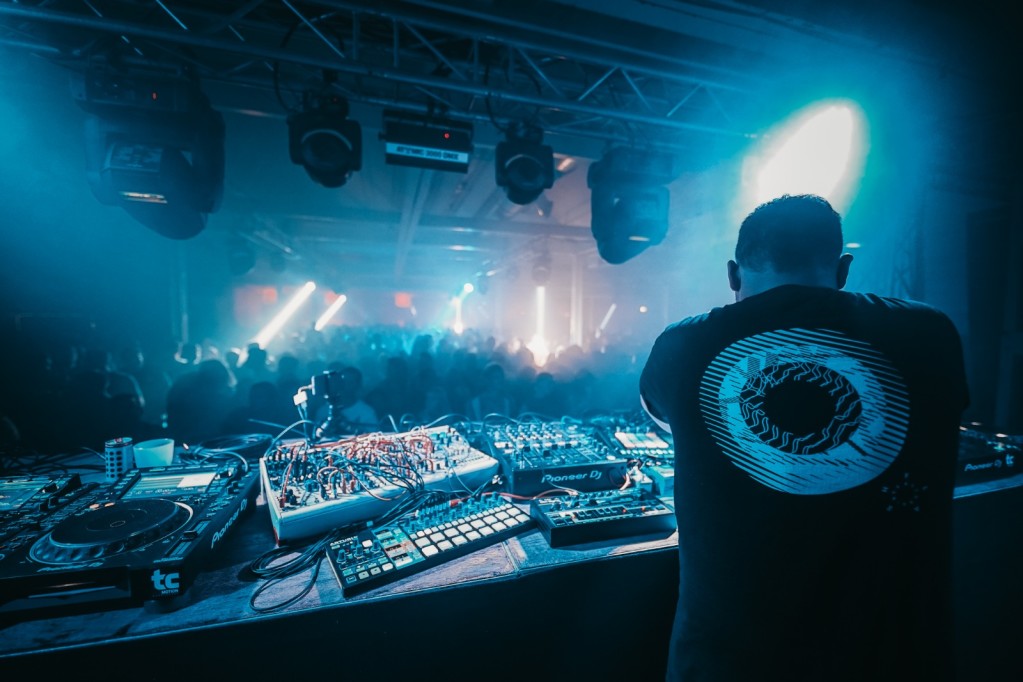
Which monitor speakers are you using?
The main monitor speakers where I create music, where I do mastering, and where I was monitoring the live stream are the Eve Audio SC407 plus a super strong 12” subwoofer, the [Eve Audio] TS112. They are not only very clear, honest and pleasant to listen to – they can also handle quite high volumes!
As an alternative for a closer sound to a club system I have the Martion Audio Bullfrogs – a very good high-end speaker with a mid-hi horn and a 15” woofer. It kind of sounds like Funktion One, but more studio-like and more honest. I don’t produce music on them, though; they are too dynamic and would lead to understatements in sound design. Everything sounded a bit boring on all other speakers when I tried that for a while. But they are not designed to be studio monitor speakers anyways.
How are you preparing songs in advance for this kind of sets? How are you storing some of those patterns, etc.?
Most of what you hear in the live set appeared somewhere in my releases before in some form; however, there is a lot of improvisation between those elements. I have around 10 stored projects in the [Arturia] Beatstep Pro which consist of beat patterns and one or two melody sequences. The same on the SP-16 and also some saved presets on the RE-303, [Roland] SH-01A, and [Novation] Circuit Mono Station. How I combine them and perform them results in the actual live performance. The possibilities of how to combine them are quite large.
Some samples of songs which I released in the past are inside the Toraiz SP-16. This is quite easy, because it can even handle loops in stereo, even though I only used one loop in this set. But sometimes I just import a vocal loop and then chop it up accordingly within the sampler.
After half a year, I usually make major changes in the setup and content, I program new melodies, exchange gear and incorporate new performance skills.
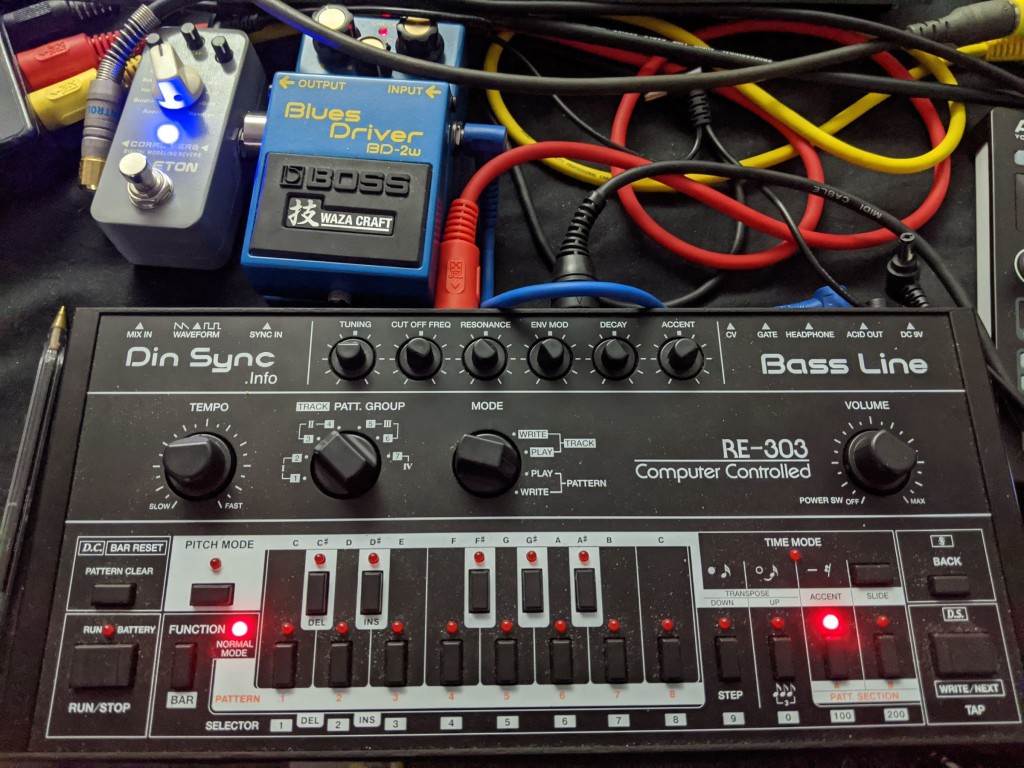
I noticed you don’t touch the mixer a whole lot. Is that also down to setting up the machines so that your mix is already set, for performance?
The reason for this is that the mixer functions almost only as a summing device in this case – I prefer to have the mixing functions inside my setup and not dependant on a mixer. As mentioned earlier, I like to use lowpass filters to filter down and eventually fade away hi-hats, snares, rides, etc. and highpass filters to (almost) remove the kick drum. The main thing I did on the main mixer was to increase the send level to have this large reverb space.
We’re obviously all looking at a period of time where we can’t get into clubs. I wondered, is developing stuff live also something that feeds into your tracks and productions? Is there an element of recording improvisation/jams there, or even developing material improvisationally?
Yes definitely – it’s all connected, every route you mentioned. But most of the time it’s like this:
I’m curious about new music gear like modules for my modular synth, hardware synths, drum machines, guitar stompboxes, and other effect units, mastering gear, and so on. Then I think of many ways I could use something, and if I believe I could benefit from it, I buy it and experiment without any goal and learn all functions, because almost always the very interesting things, the things which differ your music from others, lie in the hidden functions or in the really expert mode functions where you can tweak the little extra sound out of it.
Once I’ve found some interesting techniques for how to use it, I record many different things with it and use them here and there and make some tracks with it.
If it suits the live set I use it there, too, and often work out the sweet spots – the settings where a piece of gear is best at. This can be as simple as tuning of a kick plus distortion or saturation, but also something more complex, like a patch combining Eurorack modules in a certain way so it forms a unique instrument.
In my live setup, every ingredient does only one or two things, but in the best possible way – in order to find this out, all the above are pretty much necessary. Except the 303, it just spits out perfect acid, doesn’t it? 🙂 It does only that, but very well.
Any other live acts you want to shout out? (Either current or past or … heh, future?) Inspiration or admiration or otherwise.
Jeff Mills in a live act when he performs the 909, he is able to get the most out of this one piece of equipment. He could do that for 1h and it wouldn’t get boring – this is remarkable, like many other things he does.
Surgeon and Blawan are one of the most interesting classic Techno live acts and modular users to me. Also more acid-leaning is a newcomer on my label FLASH Recordings called Anml Mthr. Mathew Jonson is musically very interesting.
Raffaele Attanasio is also on an extremely high level musically and in terms of performance. Kink is technically very entertaining and maybe the best in improvising I know; this is almost always an eye-catcher.
Stephan Bodzin is a master in harmony and melody plus he uses the Moog in a very simple but ingenious way. Within the same field, but more towards techno, is studio wizard Hannes Bieger, who always comes up with an impressive setup and classy performance. Henrik Schwarz is musically really pleasant. Modeselektor is crazy and very entertaining! I’m sure I forgot somebody but those came in mind first.
Streaming can feel a bit lonely – sometimes it’s hard to play without that audience there, and obviously we are going to miss them no matter what! (And darkness, and dirt… well, depending on how your studio looks. Not yours!) But I’m curious, how do you approach this stream in order to try to make it slam, even without that feedback?
To be honest, I prefer to have a certain level of separation when I play live, because the more I read the crowd, interact with the audience or simply absorb the vibe, the less I can concentrate on the very complex setup and performance – all this imagination of what could work in the club or festival situation has to happen before and then has to go into the live set and performance.
However I have to say, when I come to a club where I will perform a live set, I make last-minute decisions about the track order and about certain elements which I perform according to the vibe – but I cannot be much of an entertainer while playing live – I hope the setup and musical result is entertaining enough.
While you’re at it, check out the latest from Florian on the producer side – top-notch stuff:
See an overview of all the gear and signal flow used on Florian’s site, Riemann Kollektion:
Explained: Techno Hardware Live Act Florian Meindl